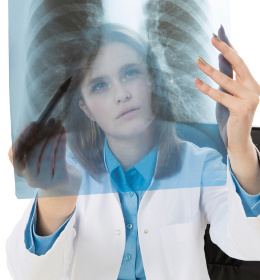Many children and adolescents tend to develop bone cancer. The following article will give some information on bone cancer in children. This article will be useful for those, who want to understand what is bone cancer, its symptoms, diagnosis, treatment and the much-needed support system.

Bone cancer is the result of an uncontrolled growth of cells present in the tissues of the bone. There are about 400 children and adolescents in the US who suffer from bone cancer. The types of primary bone cancers that are generally observed in children are as follows.
Osteosarcoma: This is the most common type of bone cancer in children and adolescents. It develops at the ends of bones present in the upper arms and legs. It usually occurs between 10 to 20 years of age, and is more common in males than females.
Ewing's Sarcoma: This is also a primary type of bone cancer that develops in the immature nerve tissue in the middle portion of the bones. It mostly affects bones of the pelvic region, upper legs, ribs, and arms.
Symptoms
Although the symptoms vary with the size and location of the tumor, some common manifestations include:
- Continued and unexplained weight loss
- Frequent headaches and vomiting, early in the morning
- Persistent swelling and pain in bones, joints, back, or legs
- Presence of a palpable lump or mass in the abdomen, neck, chest, pelvis or armpits
- Easy bruising and/or bleeding
- Increased susceptibility to infections
- Persistent nausea, with or without vomiting
- Fatigue
- Altered vision
- Recurrent fevers of unknown origin
Osteosarcoma develops in the newly-formed tissues of growing bones. Children with osteosarcoma may feel pain in the bone, or joint, around the area of the growing tumor. This pain mostly awakens the child from sleep. You may feel a lump or swelling in the area of pain. In case of a tumor in the leg, the child may limp while walking. The arm or leg muscle associated with osteosarcoma may look smaller than the muscles in the opposite arm or leg. The bone in which the tumor develops, tends to fracture easily.
In case of Ewing's sarcoma, the child may suffer from paralysis or incontinence, if the tumor develops in the spinal area. In addition, symptoms of nerve compression, namely, numbness, tingling, etc. are observed.
Note: The signs of Ewing's sarcoma are similar to many other medical conditions. Therefore, make sure you visit a doctor for the correct diagnosis.
Diagnosis
The doctor may conduct a physical examination, and inquire about full medical history of the child. He/she may check for swelling and tenderness in the bones. Blood tests may be suggested for assessing the levels of alkaline phosphatase. If a large amount of alkaline phosphatase is present in the blood, it may indicate bone cancer. If primary bone cancer is detected, the doctor may ask the parents to take the child to an appropriate cancer expert, for further diagnosis and treatment.
The tests that may be conducted for diagnosing bone cancer are:
- Radiography
- Magnetic Resonance Imaging (MRI)
- Core Needle Biopsy
- Open Biopsy
Treatment
The treatment depends on the type and stage of bone cancer, age, medical history, and the general health of the child. There are basically three types of treatment options for bone cancer:
- Surgery
- Chemotherapy
- Radiotherapy
Prognosis
Three out of every four people with osteosarcoma are cured, only if the cancer has not spread to other parts of the body. Mostly, children are treated with limb-sparing surgery, and the arm or leg continues to be used well by the children.
The child may be advised some exercises and physiotherapy to make the limbs stronger. This may continue for several months after the surgery. If amputation becomes necessary, an intense rehabilitation program may be advised. The doctor may suggest many prosthetic treatments, that may help in proper movement and independence. After the treatment sessions are completed, the child will be required to undergo regular tests like CT scan of the lungs, bone scans, and X-rays. This will help to detect relapse, if any.
After a child is detected with cancer, it turns into a harrowing experience for both the child as well as the parents. In such a case, it is very important for the entire family to support the child, and help him/her to overcome the disease.
Disclaimer: This Buzzle article is for informative purposes only, and should not be used as a substitute for professional medical advice.


 Bone cancer is the result of an uncontrolled growth of cells present in the tissues of the bone. There are about 400 children and adolescents in the US who suffer from bone cancer. The types of primary bone cancers that are generally observed in children are as follows.
Bone cancer is the result of an uncontrolled growth of cells present in the tissues of the bone. There are about 400 children and adolescents in the US who suffer from bone cancer. The types of primary bone cancers that are generally observed in children are as follows.